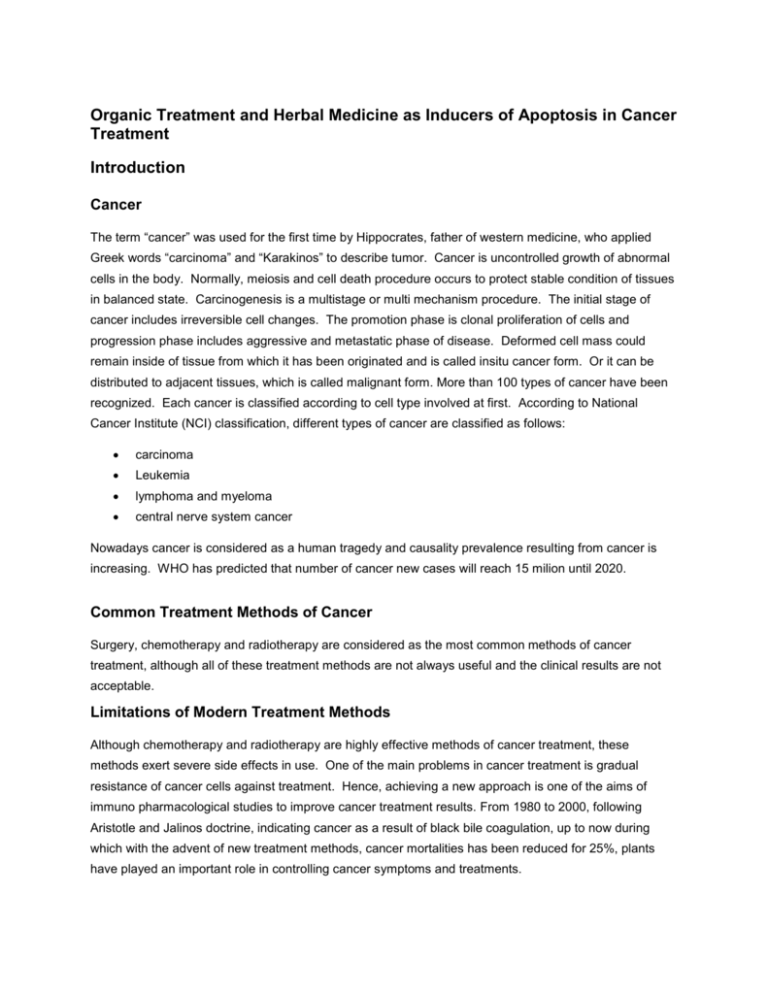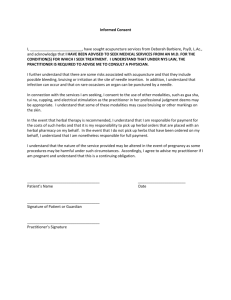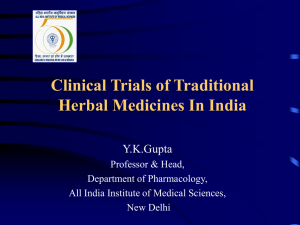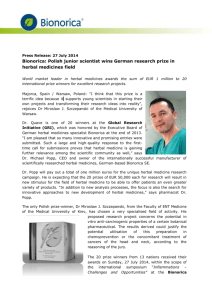Organic Treatment and Herbal Medicine as Inducers of Apoptosis in
advertisement

Organic Treatment and Herbal Medicine as Inducers of Apoptosis in Cancer Treatment Introduction Cancer The term “cancer” was used for the first time by Hippocrates, father of western medicine, who applied Greek words “carcinoma” and “Karakinos” to describe tumor. Cancer is uncontrolled growth of abnormal cells in the body. Normally, meiosis and cell death procedure occurs to protect stable condition of tissues in balanced state. Carcinogenesis is a multistage or multi mechanism procedure. The initial stage of cancer includes irreversible cell changes. The promotion phase is clonal proliferation of cells and progression phase includes aggressive and metastatic phase of disease. Deformed cell mass could remain inside of tissue from which it has been originated and is called insitu cancer form. Or it can be distributed to adjacent tissues, which is called malignant form. More than 100 types of cancer have been recognized. Each cancer is classified according to cell type involved at first. According to National Cancer Institute (NCI) classification, different types of cancer are classified as follows: carcinoma Leukemia lymphoma and myeloma central nerve system cancer Nowadays cancer is considered as a human tragedy and causality prevalence resulting from cancer is increasing. WHO has predicted that number of cancer new cases will reach 15 milion until 2020. Common Treatment Methods of Cancer Surgery, chemotherapy and radiotherapy are considered as the most common methods of cancer treatment, although all of these treatment methods are not always useful and the clinical results are not acceptable. Limitations of Modern Treatment Methods Although chemotherapy and radiotherapy are highly effective methods of cancer treatment, these methods exert severe side effects in use. One of the main problems in cancer treatment is gradual resistance of cancer cells against treatment. Hence, achieving a new approach is one of the aims of immuno pharmacological studies to improve cancer treatment results. From 1980 to 2000, following Aristotle and Jalinos doctrine, indicating cancer as a result of black bile coagulation, up to now during which with the advent of new treatment methods, cancer mortalities has been reduced for 25%, plants have played an important role in controlling cancer symptoms and treatments. Herbal Drugs Herbal drugs include plants, herbal complexes and herbal products or plant or even a combination of plants which were used thousand years before inventing modern drugs. They are also used nowadays. Herbal plants are used all over the world in different methods both in allopathic and traditional systems. Background and History With the advent of industrial revolution and introduction of modern drugs, using herbal plants were abandoned for a specific period of time. But the obstacles on the way of natural compounds studies have recently diminished mostly through using modern techniques. This has resulted in higher interest in using natural compounds in pharmaceutics. According to WHO statistics, 80% people all over the world, use traditional treatment. Sixty percent of drugs confirmed by FDA from 1984 to 1994 were isolated from natural sources specially plants. Among 121 drugs prescribed for cancer treatment, 90 are derived from herbal medicine. A study reported that among 65 new drugs registered for cancer treatment during 19812002, 48 drugs were obtained from natural products including: vinca alkaloids (vinblastine, vincristine, vindesine, vinorelbine) taxanes (paclitaxel, docetaxel) podophyllotoxin and its derivations (topothecan, irinothecan) Anthra cyclines (doxorubicin, daunorubicin, epirubicin, idarubicin) With the invent of vincristine, vinblastine and vinca alkaloid and cytotoxic podo phyllotoxin separation, the study of herbal sources for cancer treatment started drastically in 1959. These findings lead National Cancer Institute to start a program called plant collect in 1960. These findings resulted in discovery of novel chemotypes with cytotoxic activities including the taxans, camptothecins. It almost took a 30-year period (1960-1990) until these drugs development came into clinical usage. Apoptosis Apoptosis or programmed cell death is a strictly controlled pathway that is responsible for removal of unwanted cells, old and injured cells. The most important and identified characteristics of apoptosis includes morphologic changes for instance, heterochromatin core mass, cell membrane shrink and loosing organelles position in cytoplasm. In addition to key morphological changes, sophisticated molecular procedures and mechanisms are also involved. Several mechanisms alignment and molecular changes result in apoptosis inducing system. Apoptosis is either created by death receptors, which are called extrinsic pathway utilizing caspases 8 and 10. The other pathway is mitochondrial path or intrinsic pathway involving caspase 9. Recognizing involved mechanisms in cancer development is of great importance for developing neoplastic treatment. Induction of apoptosis is one the most important marker of cytotoxic antitumor agents. It has been shown that some natural compounds including plants induce apoptotic pathways that are blocked in cancer cells. Herbal compound with anti-cancer activity Phenolic compounds Human diet includes a complex of herbal polyphenols. Studies have shown that these phenols have cytotoxic effects on different tumors. Mechanisms of these compounds are carried out through apoptosis. Curcumin (Diferolelyl methane) is a phenol compound derived from rhizome of curcuma specie. Using cucrcumin, pre-clinical cancer research has shown that this plant inhibits carcinogenic procedure in the most cancers including colorectal, pancreas, gastric, and prostate. It is also effective on different stages of carcinogens, proliferation, angiogenesis and metastasis. Moreover, curcumin acts as a chemosensitizer, and results in increased activity of other anticancer factors in treating multi-drug resistant and chemotherapy-resistant resistant cancers. NF-Kβ Signaling pathway is involved in cytotoxic doxorubicin effects and its analogues; hence, curcumin increases response of tumor cells to doxorubicin through blocking NF-Kβ signaling pathway. Phase II clinical trial studies have shown that curcumin is not toxic to human to a dose of 8000 mg/day. Ginger is a phenol complex whose rhizome is used widely in traditional medicine. Phenol compounds of this plant show cytotoxic activity through apoptosis in cancer cells. Resveratrol is a phytoalexin found in grapes. It was shown that resveratrol causes apoptosis in HL60 cells and T47D (breast carcinoma cells). It induces apoptosis through CD95 signaling–dependent apoptosis in HL60 and T47D cells. Moreover, it was shown that such complex enhances CD95L expression on HL60 and T47D cells. Flavonoid Preliminary studies showed that polyhydroxy phenols such as flavenoids bring about low incidence of colon and breast cancer. Genistein is a phytosterols belonging to Flavonoids family. Apoptosis induction by genistein in human promyelocytic HL-60 leukaemic cells has been confirmed by using flow cytometric analysis. It inhibits tyrosine kinas, angiogenesis and arrests cell cycle in G2/M phase. Biocalein is a flavenoid contained in sho-saiko-to herbal medicine that induces apoptosis in cell lines of human hepato-cellular carcinoma (HCC). It acts through inhibition of topoisomerase II. Quercetin induces apoptosis by quercetin stimulated through release of cytochrome-c to the cytosol and activating of caspase9. Alkaloids 7-hydroxystaurosporine (UCN-01) is an alkaloid that increases the cytotoxic effects of cisdiamminedichloroplatinum II cytotoxicity and apoptosis in ovarian cancer cells. Furthermore, UCN-01 with 5-fluouracil has a synergetic effect on apoptosis generation. Sugiyama et.al demonstrated that induction of apoptosis and cell cycle inhibition in G1 phases is the most important determinants of cancer cells sensitivity to UCN-01 and reduces in cycling expression level plays an important role in impeding cell cycle in the G1 phase by UCN-01. Lectines For several years, Viscum album L. (VAL) has been used in adjuvant cancer therapy. VAL stimulates immune system specifically increases the activity and number of NK cells and neutrophils. In another study, cytotoxic lectine (KML-C) separated from an extract Korean mistletoe [Viscumalbum C. (coloratum)] indicated cytotoxic and apoptosis effects on tumor cells. Terpenoids Xanthorrhizol is a sesqui terpeoid complex derived from rhizome of curcuma xanthorrhizza Roxb (zingerberaceae). Different in vivo studies have shown that Xanthorrhizol inhibits formation and development of tumors. It reduces protein expression ornithine decarboxylase, cyclooxgenase-2 (cox-2) and suppressing NF-KB signaling activity. Moreover, It was shown that Xanthorrhizol exertedanti metastatic activity through reducing cox-2 and matrixmetallopeptidase 9 (MMP-9) in an in vivo mouse lung metastasis model. Performance Mechanisms of herbal medicine Drugs with herbal sources act through various mechanisms. Disorder in Cell Signal transduction Pathways The new clinical procedures emphasize blocking key biochemical pathways converting normal cells to cancer cells. The most important pathways of signal transduction in cancer, which are blocked mainly by herbal drugs, are as follows: Ap-1 and NF-KB activation pathway: It has been reported that NF-KB along with other transcription factors such as activator protein-1 (AP-1) regulates expression of genes associated with angiogenesis and aggressive growth of cancer cells. The botanic extract of mountain ginseng inhibits growth of lung cancer cells through controlling NF-KB signaling pathway. PTK Related Pathways of signal transduction: Polypeptide growth factors such as PDGF and Epidermal growth factors connect to their specific receptors known as tyrosine kinesis receptor (RTKS) resulting in a growth in signal transduction to cells. A higher expression of these growth factors and their receptors in most neoplasms has been demonstrated. MAPK Signaling Pathway: Activation of MAPK (mitogen activated protein kinase) signaling pathway induces signals for proliferation of cells. It was reported that deregulation of MAPKs was involved in carcinogenesis. Such mechanism is applied by Zengshenping (zsp) to induce apoptosis. Cox-2 Pathway: It was reported that inhibition of cyclooxygenase (COX), especially COX-2 and blocking the prostaglandin (PG) cascade might affect growth of malignant cells through inhibiting proliferation and angiogenesis. Alteration of cell cycle Regular and consistent control of cell cycle ensures normal cell proliferation. An Alteration in cell cycle may result in cancer. The existence of checkpoints in G1, G2 phases causes the continuation of cell cycle in natural and regular way. Cancerous cells are not capable of pausing proliferation at the checkpoints (G1/Sand G2/M) and consequently cell proliferation becomes deregulated. Interference with Microtubules Drugs causing problems in microtubules prevent alignment of the daughter chromosomes and consequently lead to stop of mitosis at metaphase and anaphase, which can be finally followed by apoptosis. It is worth noting that Vinca Alkaloids and taxanes are two important classes of tubulin-binding agents. Topoisomerase inhibitors There are some herbal drugs with controlling performance of topoisomerase, which have a crucial role in cancer treatment. Camptothecins inhibits topo isomerase I and epopodo phylotoxins inhibits topo isomerase II. Kinds of Herbal Medicines Two classes of Herbal Medicines include Immunomodulation herbs and Chemo preventive or Adapto genic herbs. Immunomodulation herbs One of key roles of herbal medicine in cancer treatment is their immuno modulatory effect. Cancer cells evade immune system surveillance due to low immunogenicity in most tumors. On the other hand, most cancer patients experience attenuated innate and cellular immunity (Th1). A vast majority of herbal medicines and herbal complexes stimulate innate immunity. Moreover, these complexes protect bone marrow against myelosuppressive effect of chemotherapy. This class includes Ganoderma lucidum, Sophora flavescent, Scutellaria Baicalensis, and Isatistinctoria. Ganoderma lucidum is an important medical fungus having considerable effects on immune system. In vitro and in vivo studies indicated its anti tumor activity which causes macrophages, T cells and NK cells activation and stimulated production of cytokines such as tumor necrosis factor (TNF), interleukins and interferon’s. Sophora flavescens was shown to increase leukocytes and promotes immune response. Scutellaria Baicalensis belongs to heat and toxin-clearing plant group and having antitumor and stimulatory effects on immune system that inhibits platelet aggregation and induces apoptosis. Isatistinctoria involves compounds inhibiting DNA synthesis in neoplastic cells. Stimulating immune system simultaneously. Chemopreventive Herbal Medicines Chemoprevention is a cancer inhibiting strategy using synthetic or natural complexes to interfere or prevent carcinogenesis development. Apoptosis induction is one of the main applications of chemo preventive plants. This class Saffron is provided from Crocus sativus L., a member of the large family Iridaceous. In vivo studies indicated that it is capable of inhibiting and/or retarding tumorigenesis through different mechanisms including RNA, DNA synthesis inhibition, inhibitory effect on free radical chain reactions, and inhibiting topoisomerase II. Curcumin inhibits cycloeskinase-2 production in epitilal colon cells. On the other hand, it blocks NF-KB signaling pathway through controlling IKB enzyme phosphorylation, which finally induces apoptosis in cancer cells. Why people use Herbal Medicines Herbal medicines are being used by 75-80% of world population especially those living in developing countries. It has been reported that most plants and plant extracts are used as prescribed medicines in France and Germany. The number of medicals tending to use such herbal medicines is increasing. Those suffering from cancer are inclined to use herbal medicine due to hope to cure, disease improvement, preventing disease to convert to metastatic form, supporting immunity system, reducing stress, and relaxation. Furthermore, the main aims of using herbal medicine in Cancer treatment are: Primary prevention of cancer through creating an unfavorable environment for growth of cancer cells, Prevention of a recurrence of cancer, Increasing body's immune system, and reducing side effects resulting from using modern treatment methods including chemotherapy and radiotherapy. Difference of herbal drugs and chemical drugs: In spite of similarities, there are some important differences between modern and herbal medicines. It is claimed that various parts of plant extract work together in a synergetic way. The evidence show that synergetic and buffering effects of whole plant extracts. But that these characteristics apply for all plants is still under question. Synergetic and buffering principles are applied for combination of different plants. It was reported that the combination of plants increases therapeutic effects and reduces side effects. This is in contrast with using methods of usual and chemical medicines, because using several modern drugs at the same time is avoided as much as possible. Herbal medicines are sophisticated natural compounds influencing at the same time the different phases of diseases through different mechanisms. On the other hand, chemical medicines are individual synthetic compounds interfering in an ideal condition through only a mechanism. Herbal medicines have wide therapeutic applications, being suitable for treating chronic diseases. FDA approved plant derived anticancer agents Plant derived anticancer agents in clinical use can be divided into four important groups: Vinca Alkaloids, Taxanes, podophyllotoxin, Camptothecins. Vinca Alkaloid The first herbal anti-cancer medicine was Vinca Alkaloids of Vinblastine (VLB) and Vincristine (VCR) clinically used in 1960. These herbal complexes were isolated from the Madagascar periwinkle, Catharanthus roseus G. Don. (Apocynaceae), which is also called vinca rosea. Eli Lilly et al. demonstrated that alkaloids derived from vinca rosea plant, which was first investigated with the aim of discovering diabetes drugs, inhibit tumor cell proliferation. The anti tumor mechanism of vinca Alkaloids is inhibition of microtubule assembly through tubulin interaction and disruption leading to termination of cell division. Microtubules are the essential components of cytoskeleton and play important roles in eukaryotic cellular functions such as intracellular organelle transport, cell migration, cell signaling and mitosis. Drugs able to interfere with microtubules function can terminate cell cycle and result in cell death through induction of apoptosis. Nowadays, herbal compounds, derived from vinca alkaloid, have been approved by FDA to treat some neoplasms. Vinblastine is widely used to treat breast cancer, Hodgkin’s Lymphoma (ABVD), and Kaposi’s sarcoma. Vincristine is administered for treating severe lymphoblastic leukemia, non Hodgkin Leukemia, Hodgkin Leukemia and William’s tumor. Vinorelbine is widely used in treatment of Non-small cell lung cancer (NSCLC). Taxanes Taxanes are presently considered as the most effective anti tumor agent. Various clinical trials and experimental studies have indicated that despite the side effects and low solubility in water, taxans are first choice drugs for treating breast, ovary, lung and other metastatic cancers. Taxanes, that is, Pacli taxel (Taxol) and Doce taxel (Taxotere) as well as taxanes homolog's are derived from Pacific yew bark (Taxus Brevifolia). Having collected pacific yew barks and leaves by a botanist named Arthur S.Barcly, collected, collection plan of herbal plants started by NCI in 1962. The extract was shown to have considerable cytotoxic effects on tumor cells in 1971. Mechanism of action this herbal complex was discovered in 1979. Such herbal medicine has been used to treat breast and ovary cancers and Kaposi’s sarcoma. Moreover, this drug along with cisplatin was prescribed to treat advanced ovary cancer and NSCLC. In 1992, this drug was approved by FDA to treat breast, head, and neck, prostate and gastric cancers. In 2005, Abraxane®, a nano particle Paclitaxel was approved by FDA for clinical usage to treat metastatic breast cancer. Abraxane's efficacy was confirmed in clinical trial III studies in treating NSCLC (non-small cell lung cancer) in 2010. Mechanism of Action of Taxanes: These medicines such as vinca alkaloids act through interference with microtubule function. Taxans prevents microtubules depoly merisation and in other words, taxans inhibits cell proliferation by terminating mitosis in metaphase and anaphase resulting in apoptosis. Vinca alkaloids and Taxans sometimes are called as spindle poisons; each of which acts through different mechanisms. Podophyllotoxins Epipodophyllotoxin is an isomer of podophyllotoxin family extracted from the root of the Indian podophyllum plant (Podophyllum peltatum). Etoposide and teniposide are two active and semi-synthetic compounds of Epipodophyllotoxin. Such compounds act through inhibiting topoisomerase II. Etoposide is approved by FDA for treatment of chorio carcinoma, lung cancer, ovarian and testicular cancers, lymphoma and acute myeloid leukemia. The approved indications for teniposide are central nervous system tumours, lymphoma, and bladder cancer. Plant-derived anti-cancer agents in clinical development Flavopiridol is completely synthetic, but its base is a natural product that is derived from Dysoxylum binectariferum Hook. f. (Meliaceae). In vivo studies indicated inhibitory effects of this herbal medicine on growth of lung and breast cancers. Different clinical trial studies of phases I, II have been carried out on this compound. Combretastatin is derived from South African “bush willow”, Combretum caffrum and inhibit angiogenesis and resulting in tumor necrosis. Roscovitine is another synthetic agent based on a natural product derived from Raphanus sativus L. (Brassicaceae). It acts through inhibition of cycling-dependent kinesis (Cdk). Herbal medicine safety and pharmaceutical interactions Safety is defined as conditions that a substance is considered to be safe or dangerous and weighing efficient effects against long term and short term potential side effects. Because plant products are natural, they are often considered as safe. On the other hand, different side effects have been reported following administration of plant products. Such adverse effects may occur through different mechanisms such as direct toxic effects of plant, allergic reactions, plant pollutants effects including such as lead, mercury, or arsenic, and plant pharmaceutical interactions with chemical medicines or other herbal plants. Some plants have active compounds which cause dangerous side effects including cardiotoxcity and hepato toxicity and even can produce metabolites which are carcinogen leading to alteration cellular metabolism. For example, Aristolochia fangchi plant not only causes kidney failure, but also it is a potent carcinogen. Side effects of herbal medicines may also occur due to contaminants in herbal products. In a study carried out on 260 medicines, 25% of these products were shown to contain high level of nonorganic pollutants including lead, mercury and arsenic. Series of herbal compounds including salicylic glycoside, lactonicsesquiterpens cause allergic reactions. Side effects may also occur due to pharmaceutical interactions. Types of herb-drug interaction Concurrent administration of chemical and herbal medicine can initiate pharmacodynamics and pharmacokinetic changes in prescribed drugs. Pharmacodynamics herb-drug interactions: Pharmacodynamics interactions change pathways in which a drug or natural product influences a tissue or organ. These interactions influence qualitative activities of medicine. Changes result either from increase (synergistic property) or decrease (antagonizing property) in medicine effect. For example, the main target of genistein in human prostate adenocarcinoma PC3 cells is Caspase-3and following combination usage of β-lapachone-genistein induced apoptosis is more officious. Moreover, valerian is an herbal complex used as a pain killer. The effects of valerian were reported to be decreased following administration of benzodiazepine. Black cohosh showed that such herbal medicine increases cytotoxic effects of deco taxel and doxorubicin, while it reduces cytotoxic effect of cisplatin. Pharmacokinetic herb-drug interactions: Herbal compounds can affect absorption, dissemination, metabolism, secretion and toxicity of administered medicines. Such interactions are clinically important, especially when herbal constituents affect hepatic enzymes. Herbal interactions between ginseng and varfarin were studied in a clinical trial research. The results indicated that ginseng reduced anti coagulation effects of varfarin after which INR (International normalized ratio) and varfarin plasma level reduced. It was shown that varfarin is eliminated through cytochrome P450 enzyme system. Hence, it can be claimed that ginseng can increase P450 enzyme function toward varfarin metabolism. Although most people believe that natural treatments are safe inherently, herbal medicine may cause some dangers. WHO role in developing herbal medicines WHO has recently considered herbal medicine as a holistic treatment approach? According to this hypothesis, a disease can be created following body immunity system imbalance and it is not necessarily due to external and pathologic elements. Hence, endogen herbal systems can improve these disorders and balance body immunity system. In 1991, WHO introduced some guidelines to evaluate herbal medicine? According to this guideline, herbal medicines are to pass approval processes as follows: quality control (raw herbal complexes, Plant preparation, and final products), Stability and safety assessment and providing needed documents in this regard, and evaluating medicine efficacy. Conclusion and future perspectives Since almost 50% of existing medicine is derived from plants, it is clear that natural sources, especially plants can be investigated for effective medicines in cancer treatment. Discord of medicines from natural compounds including plants had been time-consuming procedure in past. However, nowadays finding active complexes of plant has been accelerated by using modern techniques. This has resulted in herbal plants recycle. Rebirth of drugs with herbal derivations specially to treat cancer and immunologic and CNS diseases is highly considerable. Now more than 60 herbal complexes are being studied as anticancer medicine. Considering the fact that little is known about efficacy and safety of herbal products, and not paying attention to commonly used products setting, further research can improve appropriate use of plant products drastically.




